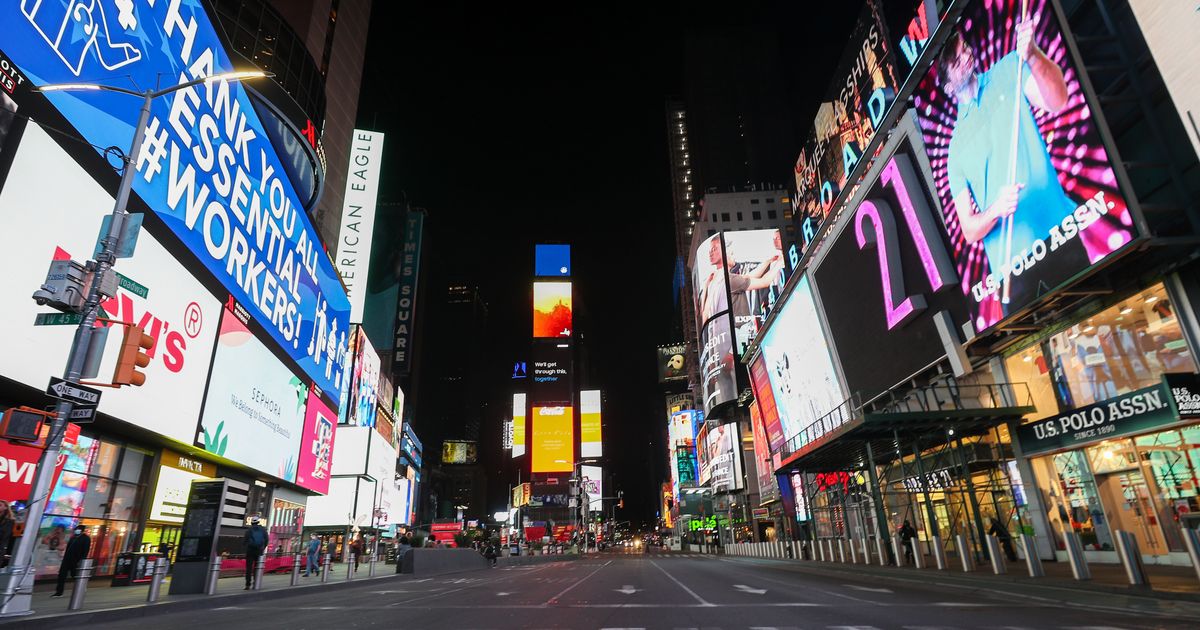Anadolu Agency via Getty Images
–
After two months of continued confinement on Friday, the city of New York, the economic and cultural capital of the United States, still does not see the end of the tunnel, raising growing doubts about the future of this metropolis symbol of crowds and effervescence.
If many European cities are gradually relaunching their economy, the first city in the United States, epicenter of the American epidemic with more than 20,000 deaths, will remain confined at least until May 28, according to a new decree from the governor of the United States. State Andrew Cuomo.
No one knows when its businesses, restaurants or theaters, which attracted millions of tourists, will be able to reopen. It is only “in the first half of June that we can start to think about relaxing the restrictions,” Mayor Bill de Blasio said on Friday.
“We are going to go slowly and carefully so as not to make mistakes and protect lives,” said De Blasio.
“We must be smart,” insists the governor, who keeps warning against a new outbreak of the virus.
The state’s beaches will be allowed to reopen as of next weekend, he added, although mayors can keep them closed if they deem it necessary.
Despite the slowdown in the epidemic in the American metropolis – the daily death toll is down sharply, below 200, and ambulance sirens have become scarce – the authorities refuse to commit to the resumption of schools in September, leaving millions of parents in limbo.
For the moment, this metropolis of 8.6 million inhabitants is far from fulfilling the necessary criteria to gradually revive the economy: continuous decline in the number of hospitalizations, people in intensive care and positive tests for the coronavirus.
In the face of prolonged confinement, New Yorkers have so far remained relatively disciplined, despite the dramatic consequences for hundreds of thousands of people now deprived of income, especially among black and Hispanic minorities.
–
While elsewhere in the United States, demonstrations have multiplied against containment, many adhere to the caution of their leaders. Especially since a hundred New York children have been suffering from rare pediatric inflammation, probably linked to the virus.
“The confinement must continue for two or three more months, because we live in a large city with a lot of people,” Denzel Charles, postman, told AFP.
“Many people are in a hurry to resume quickly (…) but in places that have reopened, it’s chaos”, underlines Kiyona Carswell, model now unemployed.
Threat of bankruptcy?
However, the more the economy remains immersed in lethargy, the more uncertainty rises about the future of a city which owes its influence to its density and permanent hyperactivity.
Many affluent New Yorkers have already left to go green, and some are considering never coming back.
“All the reasons for which we are (in New York) – restaurants, concerts … – have disappeared”, testifies Hans Robert, 49, IT manager of a large New York bank.
He and his family, 10 years in Manhattan, moved at the end of April to their country house in northern New York, from where they telecommute.
If their daughter’s school does not reopen in September, Mr. Robert does not rule out staying there. Especially since his bank is thinking, like other companies, of allowing its employees to continue working remotely.
Another question: the financial health of the city, whose tax revenues have melted with the stoppage of the economy.
The Democratic mayor brandishes the specter of bankruptcy like the one in the 1970s, which dramatically cut public services and exploded crime.
He is begging Republican President Donald Trump to validate a new $ 3 trillion aid plan, concocted by Congressional Democrats, which would bail out the city to the tune of $ 17 billion over two years. But the president has already ruled out adopting it as it is.
“New York has known a lot of crises and always ends up bouncing back,” says Maria Kopman, an anesthetist in a New York hospital. Even though everything will not be the way it used to be, “people who come here for the boil, the socialization, I don’t believe it will go away”.
WHAT TO SEE: Los Angeles beaches reopen
–


